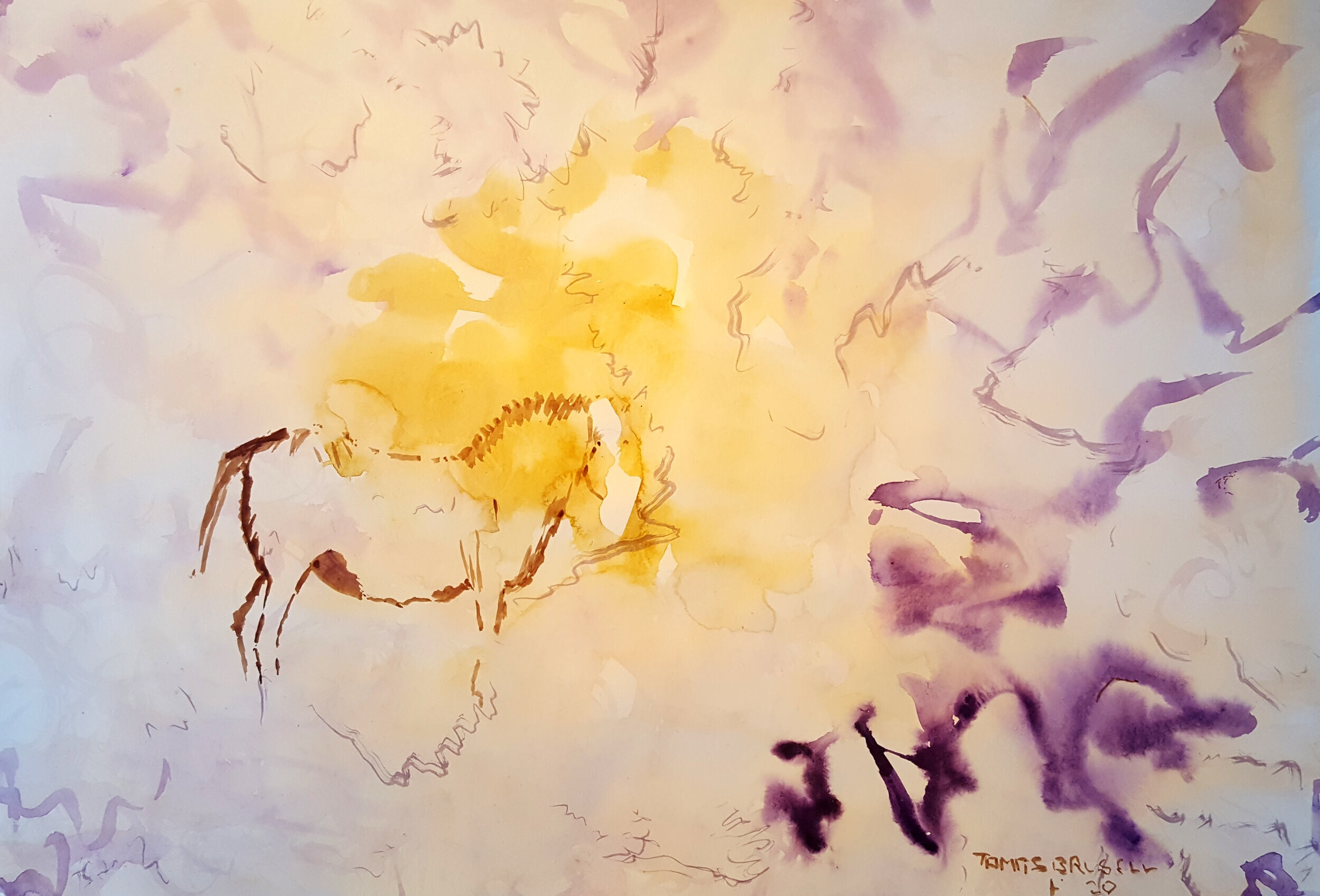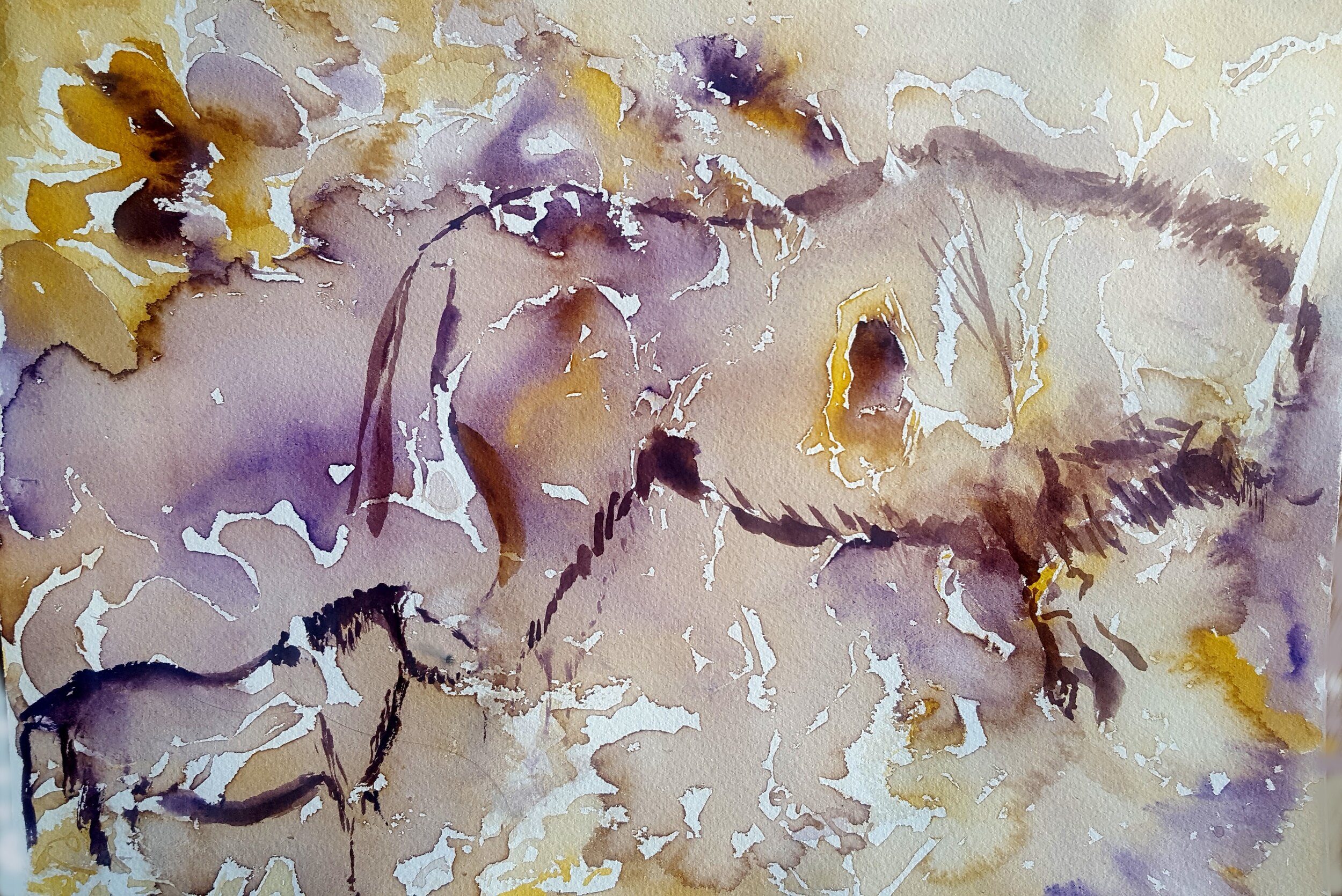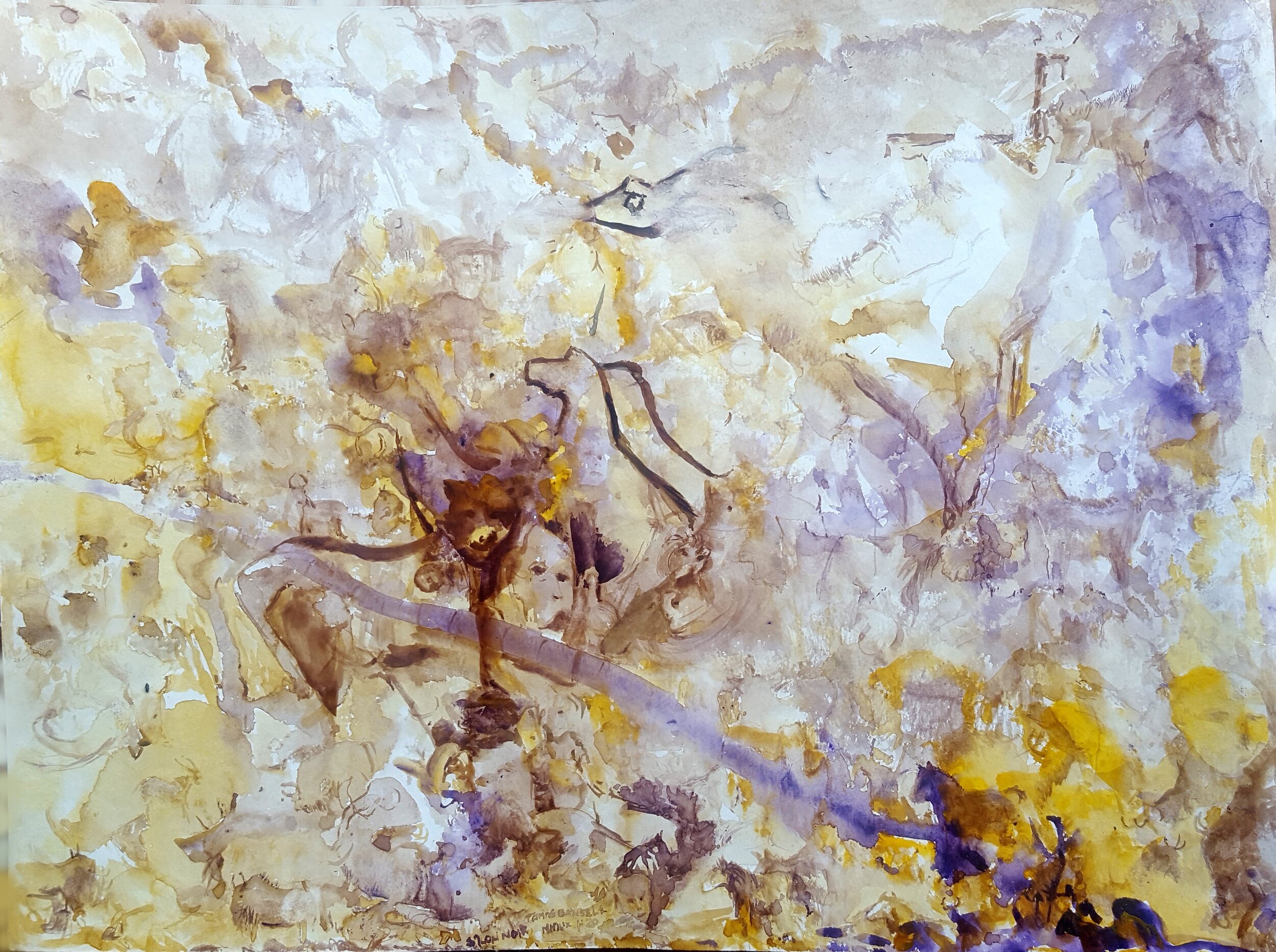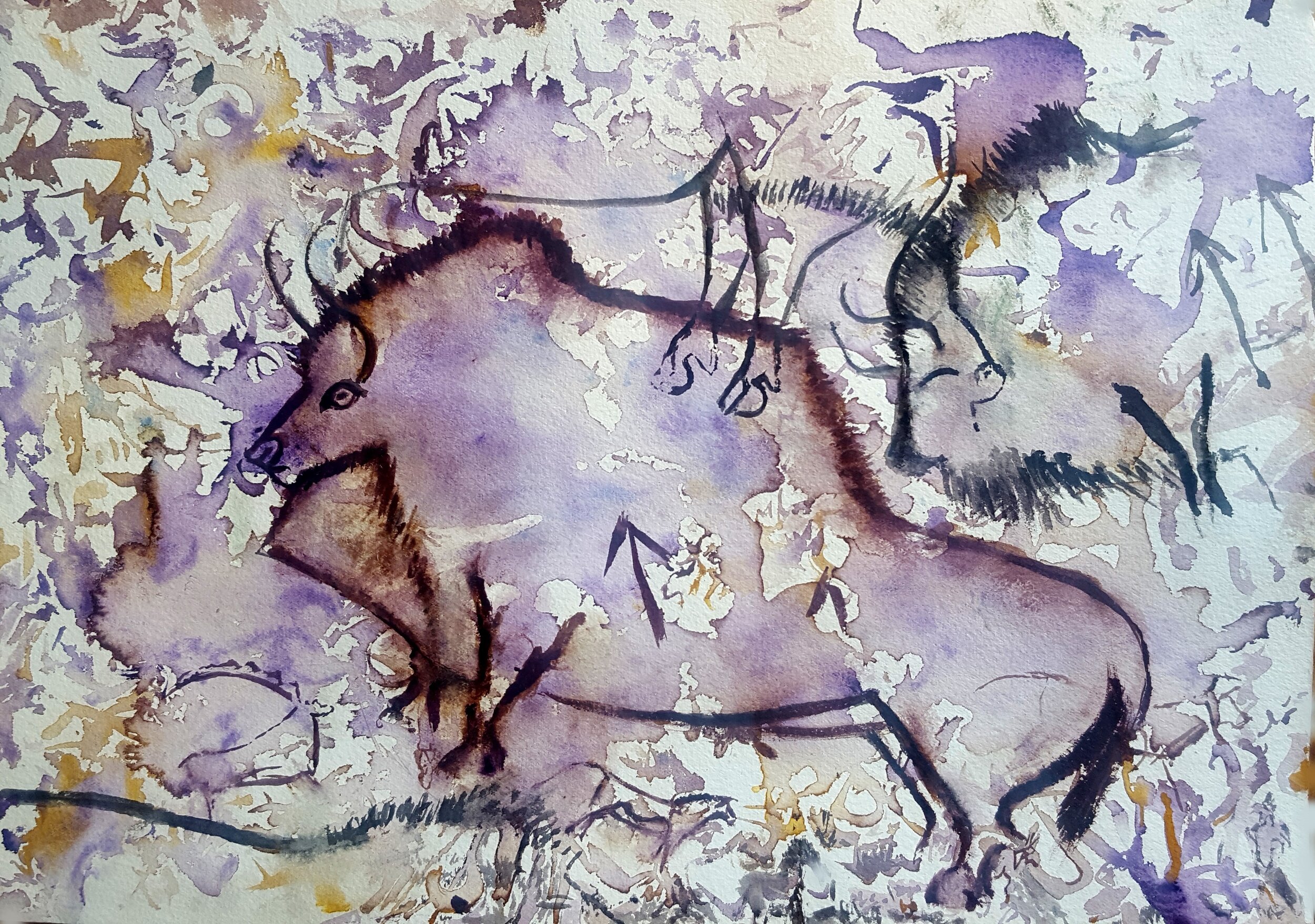I do not know what language I should write in, but since we are in a neo-Copernican era, I do this; I write in Swedish and have Google Translate in the back of my mind. It's like starting the chainsaw when helping Johan Gottlob Brusell, 1760, in his furniture carpentry. One might get the same surprising effect if one started the jet engine and showed the clergy and the stargazers in Göbleki Tepe how to travel among the warriors in 12 thousand years. They would probably raise their eyebrows if they saw a Harrier land and lift down the flat parts of the Potbelly hills. That's probably how it should feel to utilize Google Translate, but not at all; I write further, I am aware that I am sitting here writing. I am listening to the Kaya project and the summer has passed.
It is September 11, 2020 and my painting is about Fårö's nature and it is about our (us humans) culture, in that I have gone into the Niaux caves and seen cave paintings in Salon Noir, I have trained myself for this observation on Bohuslän's rocks, where I followed the rock carvers on their travels in the landscape, with a message to tell, which they chopped, beat and carved into the stone slab - art - culture - the people live and the artists tell about their lives, to those who are interested. I have learned to see the signs of the Bronze Age artists - their message - their way of looking at their world and portraying it - based on these studies throughout my adult life I have moved on to the petroglyphs in the other continents - the young in Hawaii to the oldest in Europe - over all areas of the world where there have been flat slabs - a suitable background - where the rock carvings and paintings have the best and most obvious sharpness and clarity.
There they resemble the starry sky and in the depths of the caves the cave art was drawn, the one I am fascinated by and tempted to reflect on in the depths of Niaux. There are bison, ibex and horse - perfect portraits of bison - the hooves hang, the bodies are still. These are pictures of killed animals. However, the horses look alive, as if they were liberated, free, no bridles, long-haired ice age horses. The ibex is still, the horns are down, where a few moments ago it took ten meters long leaps, over the hunter, who tumbled backwards with the spear, but was finally hit, it now lies still, forever, with the spear in its body. It is a spiritual image, it is a tragic image, it is an image of reverence for the animal, all these images of animals are images where reverence for the prey is combined with magical hunting happiness, death and life - it is an image of insight, of deep knowledge of the animals' anatomy, its essence - as much spirit as the artist, the seeing eyes, the hanging tails - otherwise the signal itself - with the tails they tell about their feelings - describe their feelings - communicate their feelings - now it hangs still - the buffalo is dead. The spear is humanly painted / carved on the animal's body, which is painted with the cave wall itself as co-creator. Both as a three-dimensional relief background and as the cave walls' angled and angled surfaces change the perspective all the time, where the movement is the viewer's thing - the images are still - the animals stand, hang or lie. It is a chapel for the report of the reality of death - as every church is - with the crucifix at the high altar. There I am in Salon Noir, in Niaux, and Spotify gives me Kaya Project - Electric Pan - that is how it feels to understand the artists in Niaux - Pan blows an electrombone and the world is absolutely new.
As amazing as the jet engine or chainsaw for pre-electric civilization is, it is to breathe digital air on Fårö and create cave paintings and/or the moor at Lauters. Where the pines and junipers rule. Where the language of the Baltic winter storms is spoken by the treetops and the relentless dialects of the dry years. There I sit these days in the changing weather and paint the sky and heath - at autumn yellow, with an unusually abundant and water-rich summer thistles and king candles, wedding flowers and grasses, and vomit-like reddish-rusty stands in the yellowing grass. It is a dead richness - but still not dead - under the ground there is life - these dry brown plants are like my dandruff - they soon blow away and disappear - and I let my awareness of Fårö's nature come to me in this nature's stories.
Earlier this summer I painted the sea. At Dämba and at Bjerget - Digerhuvud and Tungshuvud. The sky has been blue during long warm July days - and I have mixed my cerulean blue sky water - and painted its grandeur - its depth - its clouds - Ymer's thoughts - thin cirrus - bulging thick cumulus, figures have emerged as hallucinogenic creatures - animals, horses with roosters heads, rode by birdmen, there are all kinds of animals - whole and in parts - there are human bodies - round and feminine straight and masculine - there are hedonistic rituals - where life is worshiped - where art is life-affirming - the sky is warm, harmonious and happy - its meteorological message gets all mouth wrinkles up - the cheekbones are bulging - the nomad, nojd and juliman - the man of July - is happy and warm. Horny, one would say, from a body-hostile camp, but sensual from a more body-friendly and liberal side.
The sky is blue and the clouds move in - where all the joy sits - just enough rain, just the right warm, mostly sunny blue sky - a happy and Nordic summer sky, as it should be. Harmony and balance - the ecology benign, on the path of improvement, where the figures in the clouds tell of moisture and temperature - there is a neo-Copernican will to understand how water droplets condense, how the different aggregations of water rise from the sea towards these clouds - in these clouds - and the horizon cuts a cut straight into the sky - and the artist imagines the earth bend, and how the sea bends away from the point of the viewer, and Fårö's horizons often meet headlands - Lauterhorn, Norsholmen and Norsta Aurens sand cape - sharp encounters with the sea's blue-black surface.
I have painted the sea in the calm weather of the summer - slightly southerly or westerly breeze - the wave breaks moderate - almost no breakes in Strandåkersvik and at Hammars, facing south towards the sun. There I have painted the sea - I have painted down into the water by the beach - I have tried to recreate the eternal movements of the seabed, changing rhythms and light. The sun walks its course and the colors of the seafloors have changed during the day - also depending on the direction of the offshore wind, the light has been refracted differently and my brush has sought its way into the watercolor box like an insect in search of food. The brush has been sharp - a new and flexible Cotman no. 12.
I have painted the pines of the beach forest, I have painted the outermost juniper bushes where the barren foundation of the beach castle makes it possible only for the toughest one to survive. However, I have left nature as a darwinian fighting arena to others, I myself see the symbiosis - where the seabirds come with guano and the plants' seeds are served their habitat - one gives habitat to the other - the species collaborate on common resources - in good years everyone expands and rejoice - in foul years they are all reduced - there is the law of nature - unwritten - there is the beauty - unexplained - there is the natural harmony and balance - which does not preserve anything that is sick, or unsuitable for life - there I am - the artist - the gaze directed towards the whole, towards water, air and land - and then the green fire of life - the fire of life - the life of the ocher-yellow heath, the yellow fire of life of lichen on the rauks - the white and black fire of life on rock and rauk - I painted Fårö's nature and sought contact with it.
I have let it tell on my white watercolor paper about it´s spirituality - the soul of the tree, the soul of the animals, that which lives and wants to live - that which is aware that it lives - we humans - we are also nature - we have a language and it differs us from other life, especially that we have a written language and that we have art - the imagery - it makes us able to describe our consciousness - but we share this with the animals and to some extent also with the plants - even if we do not usually talk about the plants soul - but all living things are part of the world of souls - the metaphysical - the spiritual - that which deals with trying to understand death and consciousness - the great questions of what and where - the old questions - who are we - where are we going? Where did we come from? I have time to consider these questions while I paint in the moor. I let the brush run freely according to my rules (which I a long time ago coined vibrationism), and there the watercolor painting occurs, with all the shapes of these thoughts in clouds, on the water surface and the rich morphologies of the beach forest.
In the branches and canopy the faces appear - princes and prelates - there are pirates and gods - there are animals and monsters - there are extinct and now living species - there she is, and there he is.
This is how the summer fares. I have chosen some pictures from the production and are hanging them these days in gallery Brusa.
You are welcome to look further.
See you, and thanks for today.
Tomas Brusell

![Niaux II[566].jpg](https://images.squarespace-cdn.com/content/v1/5e8b3c62931ba9016aff5272/1599829766264-HL58H6G655NOVGZCW276/Niaux+II%5B566%5D.jpg)
![Niaux[567].jpg](https://images.squarespace-cdn.com/content/v1/5e8b3c62931ba9016aff5272/1599829743684-KMPC5EA5I0PCZGM6Z0TJ/Niaux%5B567%5D.jpg)
![NiauxIV[568].jpg](https://images.squarespace-cdn.com/content/v1/5e8b3c62931ba9016aff5272/1599831015756-9RMT4I8BY8DLO5HWH3I5/NiauxIV%5B568%5D.jpg)



